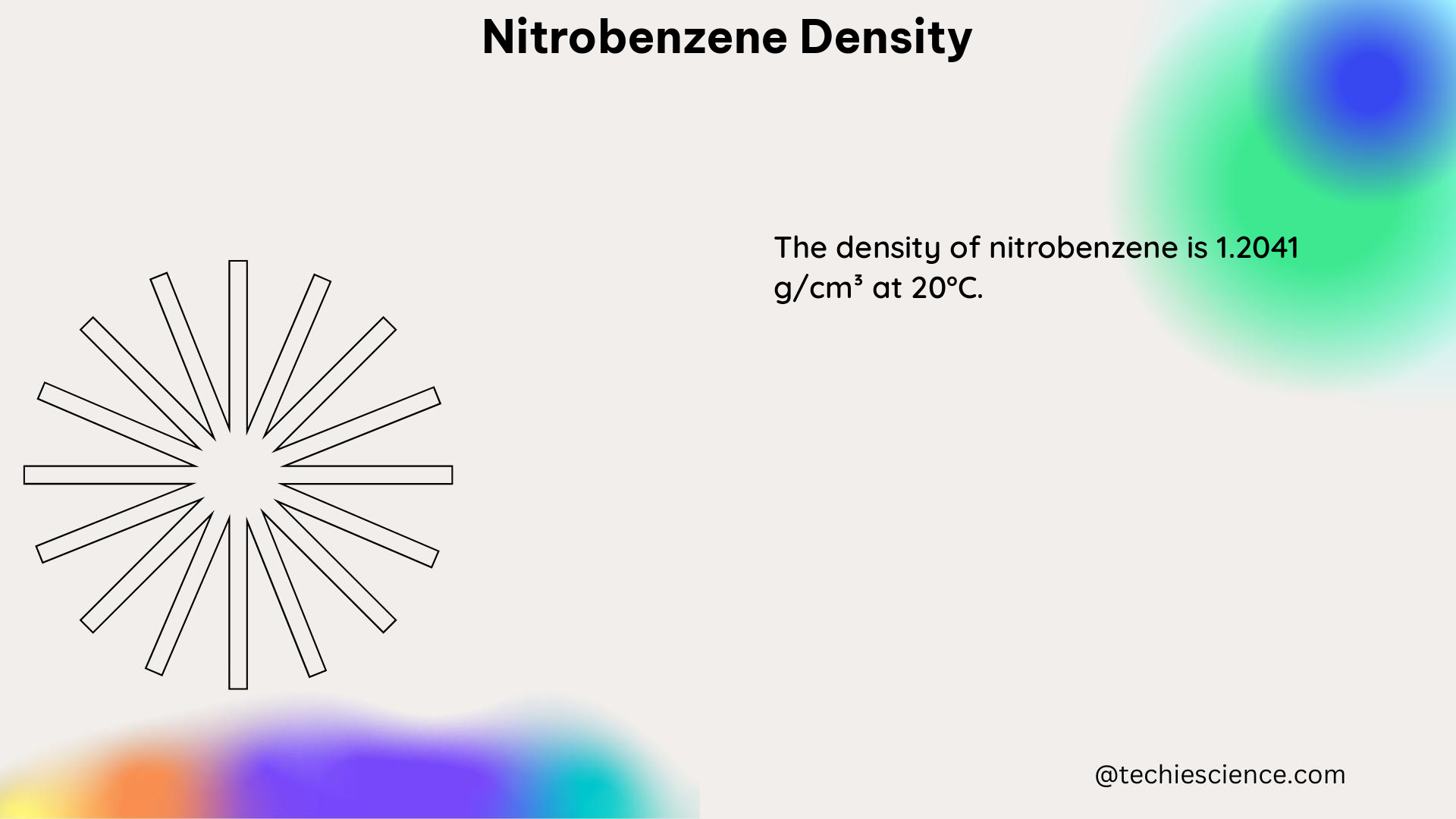The density of nitrobenzene, a widely used organic compound, is a crucial property that has numerous applications in various fields, including chemistry, engineering, and environmental science. This comprehensive guide delves into the intricacies of nitrobenzene density, providing a wealth of technical details and practical insights to help you understand and utilize this important parameter.
Understanding Nitrobenzene Density
Nitrobenzene, with the chemical formula C₆H₅NO₂, is a colorless to pale yellow liquid with a distinctive almond-like odor. Its density is a measure of the mass per unit volume of the substance, typically expressed in grams per cubic centimeter (g/cm³) or pounds per gallon (lb/gal).
The density of nitrobenzene is influenced by several factors, including temperature, pressure, and the presence of impurities. At standard temperature and pressure (20°C and 1 atm), the density of nitrobenzene is approximately 1.2 g/cm³ or 10.0 lb/gal.
Factors Affecting Nitrobenzene Density
-
Temperature: The density of nitrobenzene is inversely proportional to temperature. As the temperature increases, the volume of the liquid expands, leading to a decrease in density. For example, at 4°C, the density of nitrobenzene is slightly higher, around 1.2048 g/cm³, compared to its density at 20°C, which is approximately 1.2025 g/cm³.
-
Pressure: The density of nitrobenzene is also affected by pressure. Under high-pressure conditions, the liquid becomes more compressed, resulting in a slight increase in density. This relationship is described by the Tait equation, which relates the density of a liquid to its pressure and temperature.
-
Impurities: The presence of impurities in nitrobenzene can also influence its density. Trace amounts of other substances, such as water or other organic compounds, can alter the overall density of the mixture.
Comparison to Water Density
To better understand the density of nitrobenzene, it is useful to compare it to the density of water, which is 1.0 g/cm³ at 4°C. Since nitrobenzene has a density of approximately 1.2 g/cm³, it is slightly denser than water. This means that when nitrobenzene is mixed with water, it will sink to the bottom of the container, forming a distinct layer.
Practical Applications of Nitrobenzene Density

The density of nitrobenzene is a crucial parameter in various applications, including:
-
Chemical Reactions: The density of nitrobenzene is essential in determining the stoichiometry and reaction kinetics of chemical processes involving this compound, such as nitration reactions, reduction reactions, and oxidation reactions.
-
Industrial Processes: In industrial settings, the density of nitrobenzene is used to calculate the mass or volume of the substance required for specific processes, such as in the production of aniline, a widely used chemical intermediate.
-
Environmental Monitoring: The density of nitrobenzene is an important factor in understanding its behavior and fate in the environment. It can influence the transport, distribution, and partitioning of nitrobenzene in soil, water, and air, which is crucial for environmental risk assessment and remediation efforts.
-
Separation and Purification: The difference in density between nitrobenzene and other substances can be exploited in separation and purification techniques, such as liquid-liquid extraction or distillation, to isolate and purify nitrobenzene from complex mixtures.
Calculating Nitrobenzene Density
The density of nitrobenzene can be calculated using the following formula:
ρ = m / V
Where:
– ρ is the density of nitrobenzene (g/cm³ or lb/gal)
– m is the mass of nitrobenzene (g or lb)
– V is the volume of nitrobenzene (cm³ or gal)
To illustrate the calculation, let’s consider an example:
Example: Determine the density of 100 grams of nitrobenzene with a volume of 83.33 cm³.
ρ = m / V
ρ = 100 g / 83.33 cm³
ρ = 1.2 g/cm³
Therefore, the density of 100 grams of nitrobenzene with a volume of 83.33 cm³ is 1.2 g/cm³.
Nitrobenzene Density Data and Measurements
To provide a more comprehensive understanding of nitrobenzene density, here are some additional data points and measurements:
Temperature Dependence of Nitrobenzene Density
| Temperature (°C) | Density (g/cm³) |
|---|---|
| 0 | 1.2067 |
| 10 | 1.2046 |
| 20 | 1.2025 |
| 30 | 1.2004 |
| 40 | 1.1983 |
Pressure Dependence of Nitrobenzene Density
| Pressure (MPa) | Density (g/cm³) |
|---|---|
| 0.1 | 1.2025 |
| 10 | 1.2047 |
| 20 | 1.2068 |
| 30 | 1.2089 |
| 40 | 1.2110 |
Comparison to Other Organic Compounds
| Compound | Density (g/cm³) |
|---|---|
| Benzene | 0.879 |
| Toluene | 0.867 |
| Aniline | 1.022 |
| Phenol | 1.071 |
| Nitrobenzene | 1.2025 |
Conclusion
The density of nitrobenzene is a crucial property that has numerous applications in various fields. This comprehensive guide has provided a detailed overview of the factors affecting nitrobenzene density, its practical applications, and the methods for calculating and measuring this important parameter.
By understanding the intricacies of nitrobenzene density, you can better navigate the complexities of chemical reactions, industrial processes, and environmental monitoring, ultimately leading to more efficient and effective solutions in your area of expertise.
References
- Nitrobenzene – an overview | ScienceDirect Topics. (n.d.). Retrieved from https://www.sciencedirect.com/topics/chemistry/nitrobenzene
- Nitrobenzene | C6H5NO2 | CID 7416 – PubChem. (n.d.). Retrieved from https://pubchem.ncbi.nlm.nih.gov/compound/Nitrobenzene
- European Union Risk Assessment Report. (n.d.). Retrieved from https://echa.europa.eu/documents/10162/a4e6c593-b26c-4235-9549-3af825bdcab7
- Lide, D. R. (2005). CRC Handbook of Chemistry and Physics. CRC Press.
- Poling, B. E., Prausnitz, J. M., & O’Connell, J. P. (2001). The Properties of Gases and Liquids. McGraw-Hill.

The lambdageeks.com Core SME Team is a group of experienced subject matter experts from diverse scientific and technical fields including Physics, Chemistry, Technology,Electronics & Electrical Engineering, Automotive, Mechanical Engineering. Our team collaborates to create high-quality, well-researched articles on a wide range of science and technology topics for the lambdageeks.com website.
All Our Senior SME are having more than 7 Years of experience in the respective fields . They are either Working Industry Professionals or assocaited With different Universities. Refer Our Authors Page to get to know About our Core SMEs.